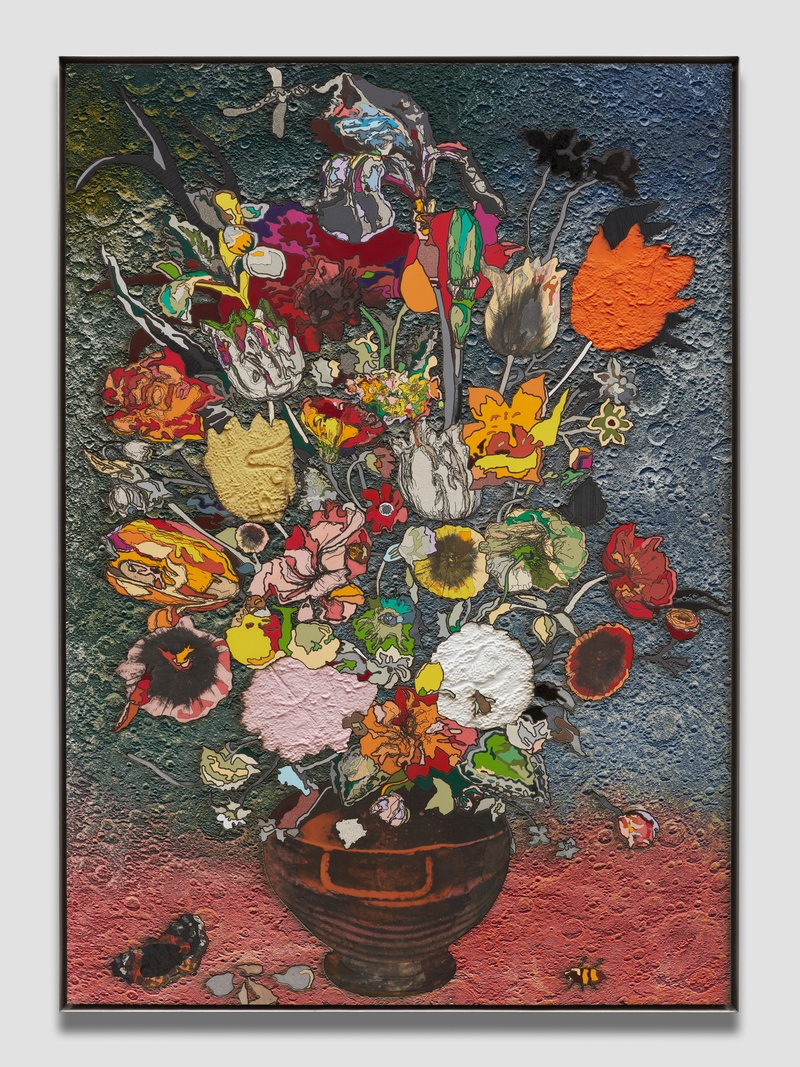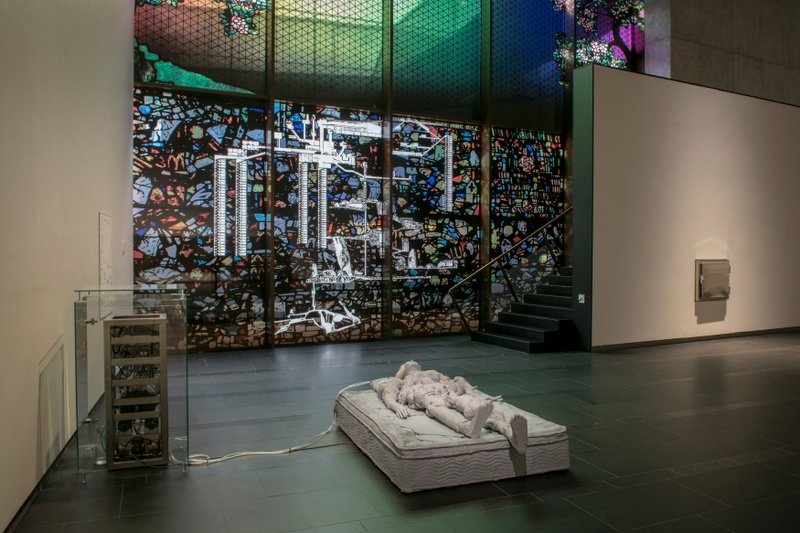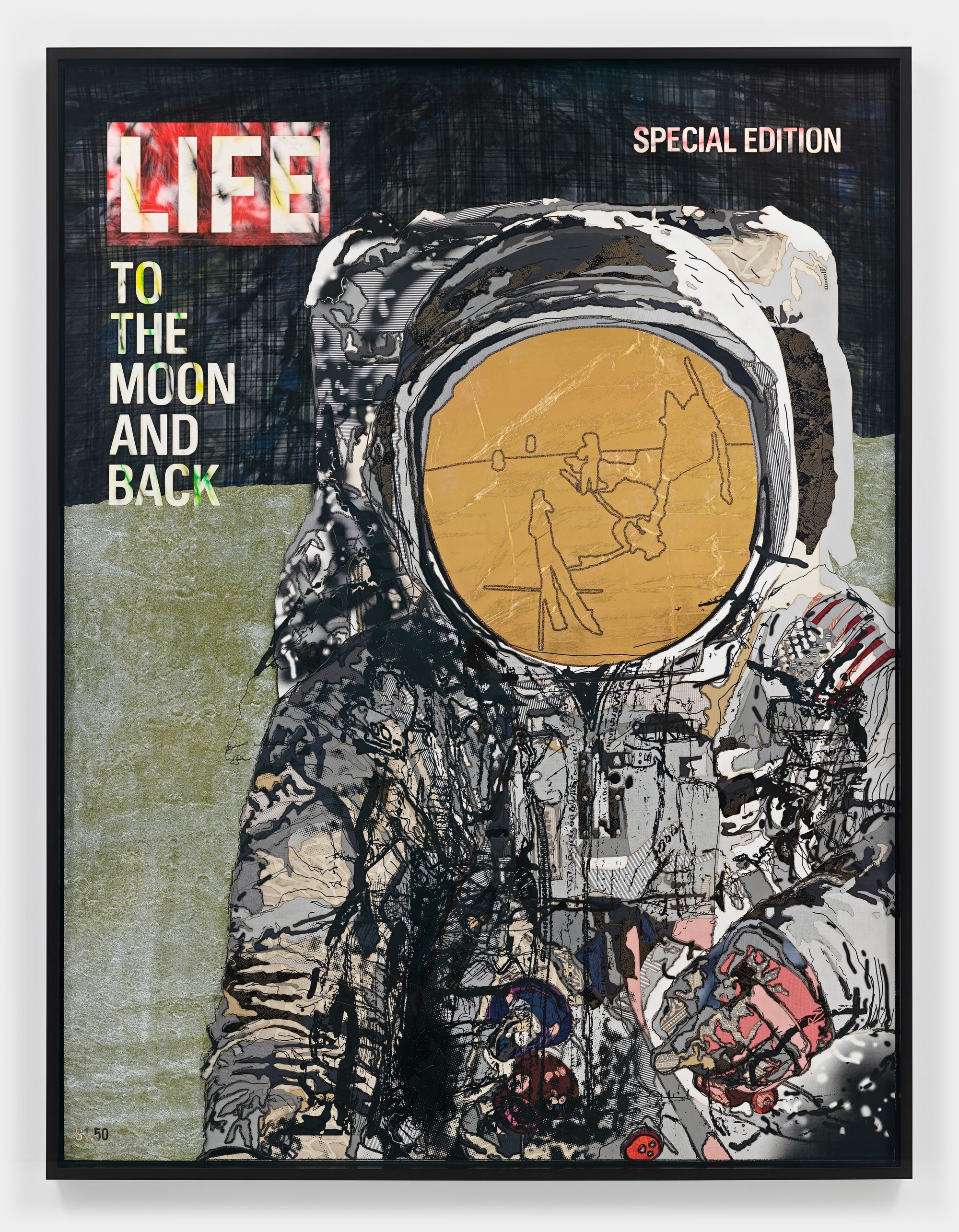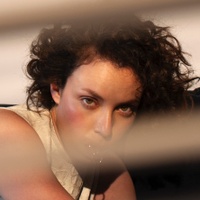On the relationship between creation and play
Prelude
Matthew Day Jackson is an American artist whose multifaceted practice encompasses sculpture, painting, collage, photography, drawing, video, performance, and installation. Born in Panorama City, California, in 1974 and currently living and working in Brooklyn and Wilson, WY, his artwork explores far-reaching subjects such as evolution of human thought, the fatal attraction of the frontier, and humanity’s faith in technological advancement. In particular, his work addresses the myth of the American Dream, exploring the forces of creation, growth, transcendence, and death through visions of its failed utopia.
Conversation
On the relationship between creation and play
Visual artist Matthew Day Jackson on embracing vulnerability, chasing down your obsessions, and the true magic of playful collaborations.
As told to Brandon Stosuy, 3895 words.
Tags: Art, Inspiration, Process, Production, Success.
Your art covers a lot of ground, both stylistically and in terms of the materials you use, and your approach varies—from racing cars, to sculpture, to games, to installation, to furniture, to things you’d hang on a wall. Other than you being the person who makes these things, how are they connected? Why’s it important to cover all these areas versus being someone who does one specific thing?
I am only alive once… this is it. There are these things that present themselves as opportunities—maybe something I’ve never seen or done before—and I feel that I owe it to myself to try it. The things that “present themselves” aren’t just magically appearing, but rather I am simply recognizing them. There is always a connection to me and my body, to history found in the present, to where I come from and who I have become. America, whiteness, masculinity, Manifest Destiny, politics, class, etc. There are always narrative connections found in the things that I am drawn to. Trying is just the first step that can lead to remarkable scenarios and into places where I’ve never been, places where I really have to use intuition and creativity to negotiate sometimes dangerous situations. In these situations I often find my truest self and my response is often surprising. I think in some cases, I am simply volunteering for one of my own studies.

Vase of Flowers, 2019 - Formica, acrylic paint on epoxy resin, fiberglass, oil paint, wood panel, stainless steel frame - Photo credit: Matthew Kroening - Courtesy of Grimm Gallery
I think creativity is something that comes alive in moments of danger, or in a situation where we don’t have an immediate answer of how to behave, or how to negotiate a particular scenario. When I’m attracted to something, whether it’s in performance, or in collaborating with people to make a role-playing game or furniture, there’s something about the integrity of the component parts of that situation that I see as being cohesive. When I see something that’s cohesive, I feel that I have something to contribute in showing connections between things that appear unrelated.
I remember, at one point, you mentioned wanting to make an exhibition that was smaller and more focused, which is not how your art usually exists. Your shows are often more wide-ranging and complicated. Was that a blip in the way you work? Was it something you did once, or is it something you want to keep trying to do?
It’s something I want to keep trying to do.
A person once said to me that the last exhibition in NYC I had was unfair, because I was asking too much from the viewer by combining all these narratives, all these materials, all this stuff… they didn’t feel like they could keep up, and they were right. I too would have gotten more from that show had I pared it down, and after reflecting on it there are plenty of changes I would have made. However at the time I’d never thought of it that way. I was trying to be as generous as I possibly could with the work that I was making.
What I’ve come to recognize, over the last five years or so, is that my practice and what I’m doing is sometimes performance, sometimes it’s a lot of other things, and they’re all happening simultaneously. But I don’t need to show them all, all the time. What I really care about is trying to communicate through this work to people that I don’t know—that maybe I’ll never meet—allowing people deeper and closer.

Installation view of Maa (Serlachuis Museum, Mänttä, Finland, May 18-September 29, 2019) Photo credit: Sampo Linkeneva
I love Louise Bourgeois and I noted during a recent revisiting of her writing when she stated that repetition was required when speaking about important things. I used to think that if I made a thing, I never had to make it again because I had already done it. I had already learned things from that one work. But as I get older, I think that I have only scratched the surface. Now I think this moment in my career is about taking responsibility for the things that I have made by reinforcing them with my current work and then hopefully creating a scenario where those things can be understood. I feel like I stutter and it is a constant push and pull between exuberance and eloquence.
Do you think age has made you a better artist?
I don’t know if it’s getting older, but experience has led me to recognize that it’s okay to ask for help. I don’t have the answers to everything and, in some cases, anything. I have learned to be open to ideas and advice. Whether it’s in the morning working out, or from friends, or even people I don’t know, I like hearing how others are handling their situations. Watching friends and loved ones who I deeply respect ask for the help they need and how they arrived at those moments has been a profound lesson for me. I feel like I am in this beautiful moment of having a capable body and just enough wisdom to recognize where I can help others, and that I also need help. Asking for help is expressing vulnerability, and being vulnerable is a very deep multi-sensory way to observe. I’m learning how to be in that space more often. I like to think that what I am talking about is more like the baleen of the whale filtering the sea for food rather than the talons of an eagle preying on field mice with precision.
Collaboration is an important part of the work as well, and being part of a team. Do you enjoy learning from other people, versus, nailing down one singular approach alone?
I am against the concept of a signature style.
I come from printmaking, and the tools for printmaking are heavy and oftentimes expensive—this is true not only for printmaking but also for ceramics, textiles, and many other craft traditions. Craft traditions most closely approximated the type of making that my family did when I was growing up. Through that experience I became aware that the quality of a thing is usually connected to some sort of measurable labor and talent. When I worked as a professional in a printmaking studio, I became well-versed in negotiating collaborative scenarios, where individuals weren’t making their own thing, but were working on a particular part of a project where the parts and the whole were entirely dependent on each other.

Brewtonya, 2018 - Plywood, epoxy, paper, acrylic paint, ceramic, insulation foam, fiberglass, steel, light fixture, paracord, Lego lunar lander - Photo credit: Ken Adlard - Courtesy of Hauser & Wirth
The mystique of the lonely, individual genius making their magnum opus is not something that I subscribe to. I also think—and maybe this is work for a therapist—that it’s in moments of feeling insignificant that when you reach out with your ideas to people who you don’t know and into scenarios that you’re not familiar with, and someone comes back with interest, then you’re like, “Wow, okay, this idea exists, and I exist and the things that I’m bringing to this scenario are valuable.” Basically, there’s somebody other than me who recognizes my existence.
So I think that the desire for collaboration rose from an emotional and spiritual place. Those relationships are always really important to me. I’m not interested in being alone. And also, we don’t make things by ourselves; we’re always making things with other people, whether we like it or not. We are a part of a continuum and everything being made is new, while also remaining dependent on the past.
You made an installation with your wife and children, and you’ve been making furniture that can be purchased as furniture. As an artist, you’ve created your own aesthetic world, and filled it with high art, and now it feels like you’re also funneling your work into the everyday outside of museums—your work can now exist as a game or furniture or family project.
I think when it’s sculpture then it’s about sculpture. When it’s the thing on the wall, it’s about painting and the history of that thing. I just recently also made a role-playing game and we really tried to just make it a game. As you mentioned the furniture, yes I just wanted it to be furniture and to exist in the realm of what furniture means. Furniture is essentially the armature for our bodies participating in activities (from eating to sleeping) which are heavily influenced by the culture in and around said furniture.

Custom Kolho two-seat couch - Photo credit: Perttu Saska - Courtesy of Made by Choice, Formica Group, Matthew Day Jackson
Regardless of what I am doing, I feel the same responsibility to scrutinize every aspect, from the bottom of the thing to the top of the thing, be it the chair or the game or performance work or a sculpture or a painting. They need to have the same integrity.
If anything, I am trying to be as sincere as possible—even if I’m saying something super nasty, I really mean it. I think sincerity is a part of vulnerability, where I might be wrong, and that people can really not like me because of how I express myself or the way that I have made something. I think that I’m always just trying to make something, whether it be a sculpture or performance or this game, or tables and chairs, that is generous and rewards those who are excited by any of it. Any of the aforementioned are places for people to come together. And I like the idea that in making art, music, food or really creating anything, we create spaces for people and ideas to meet.
As far as bringing people together, you started a residency program in Jackson Hole, Wyoming, and you used to own a house in Greenpoint that was part studio, part home, part gathering place. You did the building out of it yourself—like you were building a space that was also an art project. Sort of like the role playing game, too—creating this world, then populating it.
Yeah. That was inspired by Eleanor Roosevelt and her home called Val-Kill where she lived after FDR’s passing. I am always really aware of the time that I’m alive, which is now! I want to see the effect of my work and to share it with whomever wants to participate with the work. I am in love with our world and when I am excited by it, I want to share that excitement. I think Eleanor was vulnerable and she learned how to use a passive self to great effect and I think she lived in her moment selflessly and made great things happen. So, between Val-Kill as a physical manifestation of Eleanor to the type of person she was, I found a model for how an artist should create their world.

Installation view of Maa(Serlachuis Museum, Mänttä, Finland, May 18-September 29, 2019)Photo credit: Sampo Linkeneva
I have stated the importance of the workshop as a collaborative space and having a lot of experience in making space for production which is entirely about flexibility. I’m always trying to foster an environment for a lot to happen. We put a lot of emphasis on working space but I think I feel the type of space I am trying to engender could just be about skiing or to seeing a show. The space isn’t the thing, the space is about an environment. It’s not defined by walls and stuff. If you were to build it out of anything it would look like a cloud rather than a box… or like Pig Pen from Peanuts.
Do you find it useful to do all these things at once so you can use the momentum from one project for another project, and to keep going? You can move between bigger and smaller projects and just keep moving.
I’m trying to find a place for the better and worse parts of myself. I start my mornings with exercise, and that’s one place that I put stuff. And it becomes hugely important. Then, as far as writing, or playing make believe to make a game, that’s another place that I’ve found super great to hold particular parts of myself. Truthfully though, I think that having all the things moving at the same time is maybe not so good, and that desire for constant movement is like an addiction. I’m working on that. I have frequently confused euphoria for joy and every time I say it I feel like I am learning my left and right all over again.
Repetition allows for perfection and reveals the smaller parts of the whole. Vulnerability allows for passive observation of the world around me. Ambition is about the recognition of my ability. They don’t all work perfectly at the same time and there are other things to consider which is alive in the studio and writing. Showing the work in the world in this particular moment has forced me to be more strategic, which allows better communication, and better opportunities for the work to be understood and appreciated.
Do you want to try to do less?
No, I just want to bring all of myself to each thing I am doing. Simply doing more meant that I would only bring parts of myself. So, I am not concerned with doing less, I only want to do better.
One thing you’ve spoken to me about in the past is the idea of “play.” This came up when you were talking about creating moon-inspired Formica for furniture while in Finland, and also the role-playing game. Where does play fit into what you do, and into your process?
I invited full-grown adults to use the resources they have to come together to make some things. There were no contracts, and no real directive as to what was supposed to happen. In a very organic way, a group of about 40 people produced an art show, developed a furniture line, and created a role-playing game. I think I have become good at expressing ideas and welcoming people to join me in trying something new. This sometimes fails, but in Finland I was able to play make-believe with adults where we were using our talents and knowledge to develop some things that went beyond our individual talents and knowledge.

Installation view of Kolho presentation (Milan Design Week, Milan, April 9-14, 2019) Photo credit: Simone Fiorini
I want play to become a part of the concept of maturity as an adult in the world. I feel that the better we get at play, the better we will become at failure. I truly believe that if nothing came out of my Finnish experience I will still savor the moment every bit as much as what was produced. Play is another way of actively shifting one’s perception, allowing a different “look” at a scenario that is free from success or failure. The better adults can play, the better we become at failure and the better we can become in teaching our children how we fail and what we do to overcome this failure. Hopefully we teach them that failure is not fixed and often leads to wonderful things. Extracting the positive from low points in life is a celebration of our creativity, which is the foundation of play.
Thinking about play is a really important bi-product from the show in Finland. Whether it was a Formica surface, or furniture, or the game or the exhibition, what was most important was that a group of full-grown adults had stepped outside of their usual roles to make something new.
Was your approach to artmaking like this before Finland? Or was the Finland project the first time you worked like this?
If I listed out all of the projects I’ve done in a sequence, almost every one of them involves me trying to drag other people into the mix of it. Not because I needed to drag people into it, but it’s like one of those things where you look over the edge and see something wonderful and wanting to see someone else breach a realm of comfort to see for themselves. I want to be generous and to not be alone in discovery or excitement. I like experiencing the beautiful and exciting things that this world has to offer with other people. It makes it more real, I think. So, no, not the first time, but this time was the most special.
What is some advice you’d give to a younger artist for when success might shift or things don’t go exactly as planned?
Well, that happens to everything—the ebb and flow of life and death, those things will happen. I think that what you do when things are going well may be less crucial than what you’re doing when things are not going so well. And I think that the only advice that I can give is to pay attention. I want to pay the best attention I can as it allows me to do my job, which is to recognize that nothing has been done and that everything is always new. The difference is in the details, and “paying attention” is about increasing acuity in all of my senses to know the difference. So, pay attention.
You have kids, a family. I imagine you have a different relationship to time now than when you started. How have you adapted your process? Have you gotten better with time, more efficient, or is the relationship just different at this point?
Things that I thought were important are less important to me now. But this is a work in progress. I mean, I think I’m still adapting to my parenthood. For those of us involved in these things that really weren’t supposed to happen in the first place, there comes an anxiety that it might die if I leave it alone. And fortunately I’m getting old enough to recognize that it doesn’t, and in recognizing that it doesn’t die, but rather, in taking a step back, that it only becomes richer because you can see it better. So, I think with having children, I’m learning more in terms of adapting to them and to my role with them and only scratching the surface of its potential. The times are moving fast though. I feel like I am always trying to catch up!
Are you afraid of if you stop you’ll run out of ideas?
As I’m getting older, I’m recognizing, because there’s always something to do, that I’m going to choose the things that are really meaningful to me. There is no lack of ideas. I’m not saying that they’re good ideas, I’m just saying there’s a constant flow of potential. And I think, if anything, what I’m afraid of after this most recent experience in Finland is my expectations for what can come out of something that initially seemed insignificant. I fear that this will condition my expectations for the future, that they will be way too high. I am afraid that I won’t find people who will play with me in the way that I experienced in Finland.

Maa game set - Photo credit: Ville Karppanen - Courtesy of Serlachuis Museum, Matthew Day Jackson, Tom Morton, Timo Valjakka, Juhanna Pettersson
In terms of running out of ideas, I also believe that everything is new, nothing’s been done. And if I believe that everything is new and nothing’s been done, then my job is to really be able to discern the difference. Which can be nearly invisible, imperceivable. I don’t believe that anything has been done before so I’m not worried about that idea of originality. Originality is a stupid concern… being worried about being original? We just need to do what we do, and in doing that our work will always be uniquely ours.
Are there tendencies you need to fight against?
I am deeply impulsive and have a general disregard for danger. These two tendencies should NEVER hang out together but I have a hard time keeping them out of contact.
Do you see a line from the first work you made to what you’re what you’re working on now? Can you connect what you’re doing now with where you started?
I’ve always been after the same sort of tenor, and the narratives are all along the same lines. Since I started, I’ve been trying to make sense of this scenario of being in this body and in the experience that we have now, which is predicated on history. And so it hasn’t really changed, I guess. Maybe like not like from high school, though I think even then… I think that there’s also this aspect of death that, for a variety of reasons, has always been present in the work. Why do we stare at it? Because it’s scary, or interesting, or we just don’t know how to process it. I don’t know. Maybe that’s not a very interesting thing to say.
Obsessions are interesting.
Right. I think maybe that’s the reason why there is this wide range of materials and processes, but I’m still trying to understand the same central themes.
Do you think that through the work you’ve answered more questions or found more questions to ask?
There are more questions to ask and there were some wrong answers.

To the Moon and Back Special Edition [paper], 2019 Silkscreen, textile, acrylic paint, architectural turf, space blanket on paper
Matthew Day Jackson Recommends:
Five things I try to do…
-
Remember that time is short: I want to live in my body and do things which celebrate both my body and time. I am closest to perfecting this celebration while making things or skiing.
-
Work hard always: There are few ways to express sincerity. Labor is one of the ways I have found to be reliable.
-
Ask for help: There are people in the world that can do things better than me. There are people who are willing and capable to help me in finding new answers and finding ways to grow.
-
Say Sorry: I fuck up from time to time and to varying degrees. I try to always say sorry and then try really hard to not do it again.
-
Pay attention: The world is full of inspiration and possibility. I try to let it all in which can be very hard, but when it does get hard… refer back to #3.
- Name
- Matthew Day Jackson
- Vocation
- Visual artist
Some Things
Pagination



